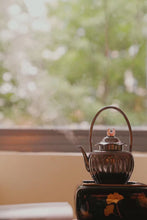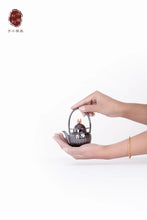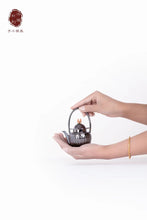
"A silver pot is the most valuable for boiling water, and a silver pot for making tea."
Boiling water in a silver pot can make the water soft and smooth, bringing a better taste.
"Ruo silk water" means that the water boiled in a silver pot is like silk, soft and smooth, with a more tea flavor and a long taste.
Lotus, the gentleman of flowers.
Zhou Dunyi once praised the lotus: "I love the lotus when it comes out of the mud without being stained, and it is clean without being demonic."
The lotus flower is clean and free from pollution, and has been favored by literati since ancient times.
Each handmade silver teapot is a precious teaware, but also an exquisite work of art. The lotus flower and silverware are skillfully combined to make an elegant teaware, and placed on the tea table, it forms a beautiful scenery by itself.
Today, Tongxinshe Teahouse recommended Mr. Hong Jike, an inheritor of intangible cultural heritage, to design and build a series of silver teaware with silver as the medium and lotus as the theme.
The "Lian Yu" pot for boiling water and making tea is made by Mr. Hong Jike himself. It is packaged in a gift box, and a certificate of Mr. Hong Jike's collection is attached to the order.
The "Hongji Treasure" in Heqing, Yunnan Province began in the Guangxu period of the Qing Dynasty. It has been passed down for five generations and still insists on using traditional pot-making techniques to make pots. Mr. Hong Jike, as the fourth generation inheritor of "Hongji Treasure", is proficient in various hand-made pot making techniques.
Hong Jike, Bai nationality, was born in 1971. The fourth generation successor of "Hung Kee Treasure". The ninth batch of intangible cultural heritage projects in Heqing County, the representative inheritor of silver jewelry forging skills (Heqing silverware forging skills).
In Buddhist culture, the lotus is a flower full of Zen.
The Buddhist scriptures can be called the "Lotus Sutra", the Buddhist country is also called the "Lotus Realm", the Buddhist seat is called the "Lotus Seat" or "Liantai", the Buddhist temple is called "Lian Yu", the monk's house is called "Lotus House", and the cassock is called "Lotus Clothes". The history of the traditional Chinese lotus pattern can be traced back to the Yangshao culture period or even earlier, and it is a classic decorative pattern with a long history in my country.
The lotus patterns before the Wei, Jin, Southern and Northern Dynasties were relatively simple; with the introduction of Buddhist lotus patterns, the Sui and Tang Dynasties were represented by Baoxiang patterns and twining lotus patterns, which were rich and luxurious; during the Song and Yuan Dynasties, with the improvement of social production levels, at this time In addition to the lotus pattern on porcelain, it is also widely used in painting, textiles, etc. However, in the Ming and Qing Dynasties, the lotus pattern not only gradually became brighter in color, but also began to be bold and exaggerated. "Pictures must be intentional, meaning must be "Auspicious" has also become mainstream.
The lotus has also been endowed with many beautiful meanings accordingly.
A lotus flower symbolizes cleanliness, double lotus flower symbolizes the love of husband and wife, lotus flower and carp imply "more than one year after another, rich every year".
There are two types of pots for boiling water and tea making, which are rare in Mr. Hong's pot-making career.
The body of the pot is designed as a tall barrel, which is very delicate overall.
The pot body is engraved with lotus petal patterns, which are symmetrical from left to right, up and down. From the bottom to the top, it looks like a large piece of lotus petals, which stand upright and wrap the whole body of the pot. It is an inverted short petal, which echoes up and down, forming a symmetrical and orderly aesthetic experience.
It can be used as two kinds of practical scene pots for boiling water and making tea pots, and it has become an indispensable beauty in the tea banquet. The double-circle turning is used as the shoulder of the pot, and the curve is moderate. The blades of grass are curled and continuous. The combination of lotus and cattail grass symbolizes "one product is clean and honest".
The lid of the pot covers the pot in the shape of a lotus leaf. The curved and smooth lotus mouth gives the whole pot a natural and dynamic aesthetic feeling. The pot button is inlaid with three-dimensional lotus flowers made of agate material. A sense of nobility and sophistication, the high-curved beam handle is treated with metal heat-insulation connection, the upper and lower proportions are appropriate, harmonious and beautiful, and the bottom is closed, engraved with "Hong Jike" system, which is also a symbol of the status of this pot.
The whole body of the pot is treated with silver-smoked anti-oxidation treatment, which retains the metal texture and adds a sense of dignity. The built-in long-hole filter outlet is used to boil water and tea, and the soup is made quickly, which is easy to use.
The delivery is accompanied by a collection certificate of Mr. Hong Jike, and the delivery is packed in a gift box.
“煮水以银壶为贵,泡茶以银壶为尊。”
银壶煮水,可使水质柔薄爽滑,带来更好口感。
“若绢水”,说的就是银壶煮的水如丝绢一般,柔顺爽滑,更显茶韵,口感绵长。
莲,花之君子者也。
周敦颐曾盛赞莲花:“予独爱莲之出淤泥而不染,濯清涟而不妖。”
莲花洁净,不染污浊,自古受到文人的偏爱。
每一把手工银壶都是一件贵重的茶器,同时也是一件精美的艺术品,将莲花与银器巧妙结合,制成雅致茶器,置于茶席之上,自成一道亮丽的风景。
今天, 同心舍茶馆推荐非遗传承人洪继科老师,以银为介、莲为题,设计打造了系列银茶器。
「莲语」煮水、泡茶壶,为洪继科老师亲工制作,礼盒包装,下单附洪继科老师收藏证书。
云南鹤庆的「洪记宝藏」,始于清朝光绪年间,至今已有五代传承,仍在坚持使用传统制壶技艺制壶。洪继科老师作为「洪记宝藏」第四代传人,熟练掌握多种手工制壶工艺。
洪继科,白族,1971年出生。「洪记宝藏」第四代传人。鹤庆县第九批非物质文化遗产项目,银饰锻制技艺(鹤庆银器锻制技艺)代表性传承人。
在佛教文化中,莲花是充满禅意的花。
佛经可称“莲经”,佛国也称“莲界”,佛座称“莲座”或“莲台”,佛寺称“莲宇”,僧舍称“莲房”,袈裟称“莲衣”。中国传统莲花纹样的历史可以追溯至仰韶文化时期甚至更早,是我国历史悠久的经典装饰纹样。
魏晋南北朝之前的莲花纹样相对简单;随着佛教莲花纹样的传入,隋唐时期以宝相纹和缠枝莲纹样为代表,富丽华贵;宋元时期,随着社会生产水平的提高,此时的莲花纹样走向清秀淡雅,除去瓷器上的莲花纹样,在绘画、纺织等方面也广泛使用,而发展至明清,莲花纹样不但色彩逐渐明艳,造型也开始大胆夸张,“图必有意,意必吉祥”也成为主流。
莲花也相应被赋予了许多美好的寓意。
一茎莲花象征一品清廉、并蒂莲花象征夫妻恩爱、莲花与鲤鱼寓意“连年有余、年年富裕”。
此壶型分别做煮水壶与泡茶壶两款,在洪老师的制壶生涯中是很少见的。
壶身做高身桶设计,整体十分秀气。
壶体刻莲花瓣纹,左右上下皆为对称形,从下往上看为大片的荷花瓣,片片直立包裹整个壶身,因对称又十分精致的錾刻花瓣纹,至上往下看,又是倒立的短瓣花瓣,上下呼应,形成一种对称又有秩序的美学体验。
做烧水煮茶壶、泡茶壶两种实用场景壶,成为茶席间成为不可或缺的美景,双圈转折做壶肩,曲线弧度适中,整周錾刻卷草纹,长长的线条十分流畅,草叶卷曲,连绵不断。莲花与蒲草搭配在一起,象征“一品清廉”。
壶盖呈荷叶形态覆盖在壶上,曲线流畅的荷口边给予整个壶一种自然动态的美感,壶钮镶嵌玛瑙材质立体荷花,浅浅的红色点缀其上,给与壶本身又增提了一份高贵和精致感,高曲线提梁把手,做金属隔热衔接处理,上下比例适宜,和谐美观,底部收口,刻“洪继科”制,也是给予此壶身份的象征。
壶身整体做熏银防氧化处理,保留金属质感的同时又更增一分尊贵感,内置长孔过滤出水口,煮水煮茶,出汤利索,称手好用。
发货附洪继科老师收藏证书,礼盒包装发货。























































































